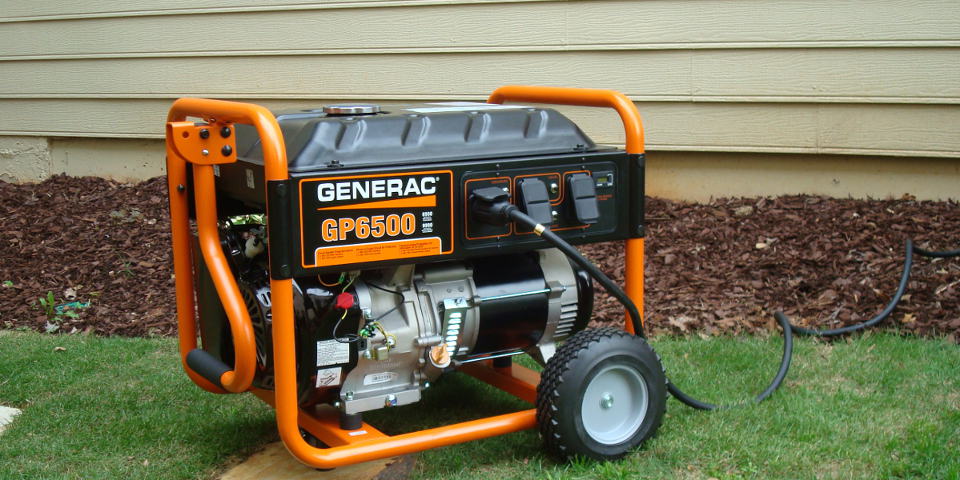How to Use a Portable Generator for Emergency Power

A Generac GP6500 with Electric Start Connected and 30-Amp Generator Cord Plugged into a Manual Transfer Switch Inlet Box During a Power Outage!
A Portable Generator for a House can supply a few essential or critical appliances, or large portions of an entire home during a power outage. Although not automatic like a standby generator, portables are a viable solution when utility power fails. Smaller portables can supply power one or two appliances and a few lights or charge a cell phone. No matter the size or capacity, they produce electricity at common household voltages making safety and care important.
Power outages are regional events and can affect just a few homes or entire neighborhoods covering many blocks. They occur during storms, traffic accidents, or when a wandering raccoon decides to snuggle up to transformer for its warmth.
If the outage area is small, it may only take an hour or so for the utility to restore power. Very often, it takes more than an hour for the utility to even know what caused the outage. Meanwhile, you’re wondering about the refrigerator and freezer, the sump pump, and keeping your phone charged.
Buyer Guide: The Best Portable Generator for Home Backup
These are everyday needs that we hardly even think about until something goes wrong. On a hot day, the food in a refrigerator can start to spoil in just four hours and the freezer might last one day it it's full and was at zero degrees or colder.
When the power is out, portable home generators keep your essential appliances and circuits on. With the right connection and generator, your home stays comfortable even in the winter cold or summer heat.
Safety First
Read the Manual

No one ever picks up an owner’s manual just to have something to read, but the most important safety feature is knowing your portable generator. Most people take their generator out of the box or off the crate, start it once, and then it goes in the garage or shed and waits for the next outage. Two years later the power goes out in a storm and they end up outside in the rain trying to remember what to do—a recipe for dangerous mistakes.
1. Outside Use Only
Do Not run a generator inside a house, garage, or shed. Never. The carbon monoxide in a portable generator’s exhaust can reach lethal levels in a few minutes. Every year there, hospitalizations and fatalities occur because someone ran a generator in the basement or other room and thought that opening the window would provide sufficient ventilation. It won’t.
2. Placement
Keep the generator at least 20 feet away from the house. Differences in air pressure and temperature between the inside and outside can create a draft that pulls exhaust fumes into the home. Don’t forget that your generator exhaust could affect your neighbors too. Don’t place the generator where the wind can push the exhaust against windows, vents, doors, or other openings. Use a carbon monoxide detector indoors to alert you of possible poisoning before it happens.
3. Weather
Setting up in the pouring rain is dangerous to you and could damage the generator. Water and electricity are never a happy combination and chances are good that your portable was not designed for use in the rain. Read your manual if there is any doubt. Specially designed generator tents made to fit over your generator will protect it from the rain, but follow all safety rules in the manual.
Generator Placement for Safety
5. Extension Cords
Only purchase and use extension cords rated for outdoor use that match the circuit breaker of the generator outlet. 20-amp outlets require a 20-amp extension cord. Accidentally overloading the cord is a serious fire hazard and burn hazard. Always use 3-wire extension cords and never attempt to defeat the ground blade.
Generator Power Cords and Extension Cords
6. Do Not Backfeed
Backfeeding is dangerous and could endanger utility workers. Regardless of what you read on internet forums and DIY blogs, it is dangerous and if you harm or kill a utility worker, you are held responsible. Backfeeding means using a homemade generator cord (sometimes called a suicide cord) to plug into an appliance outlet such as your dryer or range. This energizes your entire house and most likely, your generator cannot handle that kind of load.
Electricity may travel through your main panel back to the transformer on the pole which works just as well in reverse. Distribution lines typically carry up to 50,000 volts. Your transformer will step up your 240-volt generator voltage to distribution voltage and send it down the line. A utility worker who expects a dead line could be injured. Or a neighbor who thinks the power is out could also be put in danger by a downed line that is suddenly energized.
Very simply. Backfeeding is Dangerous. Illegal in some jurisdictions. Not worth the risk. Don’t Backfeed.
The safest way to power your home is through a manual transfer switch for a portable generator.
Portable Generator Safety Rules to Live By
Setup the Generator
Remember to choose a safe location that is at least 20 feet away from your home and where the exhaust won’t blow against your house or the neighbor’s house. Protect the generator from rain and snow, but don’t operate it inside a building. Use outdoor extension cords rated for the outlets you connect them to.
1. Check the oil
Some generators have a low-oil shutdown feature, others do not. Operating an engine without enough oil could damage it and will void the warranty. Always check the oil first and top it off if necessary. Remember that these hard-working engines have required maintenance periods measured in hours. Each time you start the generator—including during refueling breaks—check the oil first.
2. Fill the Tank
Fresh gasoline is a must and a grade without ethanol is best. Use a fuel stabilizer for stored gasoline and rotate your supply at least once every six months. Take the fuel can to the gas station, pour the older fuel into your tank, then fill it again from the pump. Old fuel can make engines hard to start or even prevent them from starting at all.
TIP: Propane stores indefinitely. A Portable Propane Generator solves the old fuel problem.
3. Unplug the Cords
Do not start your portable generator when it is connected to a load. It was not designed for this operation and you could cause a condition where the generator is unable to produce electricity even while the engine runs. Remember to remove your loads before you shut it off for the same reason. Unplug all the extension cords before starting or stopping.
Pro-Tip: Eliminate extension cords all together. Have an electrician install a manual transfer switch and supply power to the circuits you need. Not only do you get rid of the cords and simplify setup, you can power hard-wired appliances like furnaces, well pumps, and air conditioners with the right generator.
Get it Started
The basic steps for starting any engine is applicable to all portable generators, but there may be special steps involved or steps you don’t need. This is where the owner’s manual can help. Instructions on the generator may be hard to read in the dark. Write them on a card that you keep in a plastic zipper bag with the generator for easy reference.
1. Fuel Valve
Turn the fuel valve to the “ON” position. This allows fuel to reach the carburetor for starting and running the engine.
2. Choke
Turn the choke to “On” or “Full”. The choke allows the generator to use more fuel during starting and warmup and makes it easier for the engine to start.
3. Ignition Switch
Put the ignition switch or key in the “On” or “RUN” position. The ignition switch controls the flow of electricity to the spark plug. When it’s off, the spark plug can’t fire and the engine won’t run.
4. Starter / Pull Cord
An electric starter turns the engine for you while the carburetor supplies fuel and the spark plug fires. The engine should start within a few seconds. If pushing the starter button has no effect, a dead battery may be the problem. Use the pull cord or recoil cord instead.
Grasp the pull cord and pull it straight out. Some force is necessary, but don’t pull it too far. If you haven’t used the generator before, an experimental pull or two should help you determine the cord length. Expect to feel some resistance. Several pulls are sometimes necessary, especially after long periods of disuse.
5. Engine Starts
Let the engine run a few seconds, but long warm ups are usually unnecessary. Move the choke to halfway between “ON” and “RUN” if available, or to the “RUN” position if not. From halfway, wait a few more seconds, then turn it to “RUN”.
Make Connections
Do remember to use the extension cords rated for outdoor use and sized to the generator receptable . A 15-amp receptacle requires a 15-amp cord. A 20-amp receptacle requires a 20-amp cord. Cords with multiple outlets on the end are best for multiple indoor connections. Don’t string multiple extension cords together outside.
1. Run Cords
Keep the cords out of puddles or anywhere they might fall into water. Choose the shortest route possible and don’t pinch cords in doors or windows.
2. Connect the Generator
Plug the cords into the generator. If your generator has multiple outlets, make sure you are not overloading one circuit breaker when another is available. A Dual Receptacle is usually controlled by a single breaker. Two dual receptacles will each have their own breaker.
3. Connect Appliances
Complete your circuits by plugging in appliances. If you must add extension cords in the house, remember to use cords rated for the generator outlet they are plugged into.
Refueling for Extended Operation
Always shut down your portable generator to refuel. Don't fill the tank when the engine is running. Remember to remove all your electrical loads before you shut down to refuel and check the oil.
1. Remove Loads
Unplug all extension cords from the generator. This prevents the loss of residual magnetism which is required at startup to produce electricity. Not all generators require this, but it’s a good practice.
2. Ignition OFF
Turn the generator off by moving the ignition switch to the “OFF” position.
3. Cool
Never refuel while the generator is hot. A minor gasoline spill can ignite and the resulting fire may injure you severely and damage the generator. A ten-minute wait is usually sufficient. While you’re waiting, check the oil.
4. Check Oil
While you’re waiting for the generator to cool, check the oil and if necessary, top it off with fresh oil. Keep the oil level as close to the full mark on the dip stick as possible without adding too much. If the generator run time is near the maintenance interval, change the oil and perform any other maintenance required before starting and running the unit.
5. Fill the Tank
Fill up the tank and use care not to overfill. Clean up spilled gasoline and don’t run the generator on top of a fuel spill. Don’t forget to replace the fuel tank cap when you’re done and move the gasoline tank away from the generator.
6. Restart
Turn the ignition switch to “ON” or “RUN”. Usually if the generator engine is still warm, the choke is unnecessary. Start the generator and let it run for a few seconds.
7. Reconnect
Once the generator is running again, you may reconnect the extension cords.
Storage
Eventually the utility company will restore power and your portable goes back into storage until the next time you need it.
1. Shutdown
Remove all the extension cords to prevent loss of residual magnetism. The last thing you want is no power the next time you need the generator.
2. Fuel Off
Shut down the generator by turning the fuel switch off. The generator will run for a minute or two before it shuts off. This drains the carburetor of fuel and prevents clogging of the internal ports and passageways that the gasoline travels through. Next time you need the generator, it will start as easily as the first time.
3. Cool
Allow the generator to cool before putting it away. This is a good time to check the oil and refill if needed. Perform any required maintenance so it’s ready next time you use it.
4. Store
Store your generator in a garage or shed, but never in your house. The same is true for your supply of gasoline. Remember to rotate your gasoline every six months, including the gasoline left in the generator fuel tank. A simple siphon hose will drain most of the gasoline from the fuel tank into your fuel container.
Manual Transfer Switch Upgrade
 If your portable generator has enough power, you can supply electricity to multiple appliances including air conditioners, furnaces, your refrigerator and freezer, and your sump pump along with a few convenience receptacles.
If your portable generator has enough power, you can supply electricity to multiple appliances including air conditioners, furnaces, your refrigerator and freezer, and your sump pump along with a few convenience receptacles.
Advantages—You can supply electricity to specific circuits including hard-wired appliances. Without a transfer switch you are limited to appliances with cords that plug into a regular wall outlet. Forget about dragging extension cords through the rain. A single Generator Power Cord connects to a 30-amp or 50-amp receptacle on your portable generator and plugs into an inlet box on the house.
And with a manual transfer switch installed by a licensed electrician, you won’t endanger electrical workers or your neighbors by accidentally energizing power lines.
DIY: Planning a Manual Transfer Switch Installation
Standby Generator Upgrade
 Portable Generators do a great job when you’re home and can literally save you thousands by keeping your refrigerator and freezer cold and operating your sump pump during a power outage. Downfalls include needing someone to operate them; electrocution hazard when operating in the pouring rain; they require regular refueling; they supply a very limited amount of power.
Portable Generators do a great job when you’re home and can literally save you thousands by keeping your refrigerator and freezer cold and operating your sump pump during a power outage. Downfalls include needing someone to operate them; electrocution hazard when operating in the pouring rain; they require regular refueling; they supply a very limited amount of power.
Standby Generators have fewer limitations. They operate automatically in any kind of weather and don’t require your help to get them started. Because they are permanently connected to your home’s electrical system, there are no power cords or extension cords to run. And they operate on your home’s natural gas or propane supply, so you don’t have go out and shut them down, wait for them to cool so you can refuel, and then start them up again.
Choose the Right Automatic Transfer Switch for Standby Generators
When the power goes out, a home backup generator detects the outage the instant it happens. The generator starts. The automatic transfer switch disconnects the service panel from the utility and connects to the generator. Your home is supplied with power. Typically, the transfer takes place just seconds after the outage occurs.
It won’t matter if you are at home, at work, or halfway around the globe. A standby generator works automatically to protect your family and property. With remote access and an internet connection, you can connect using a smart phone, tablet, laptop, or desktop computer to check status or receive updates as they occur. Even schedule maintenance when it’s required.
Updated November 8, 2021






